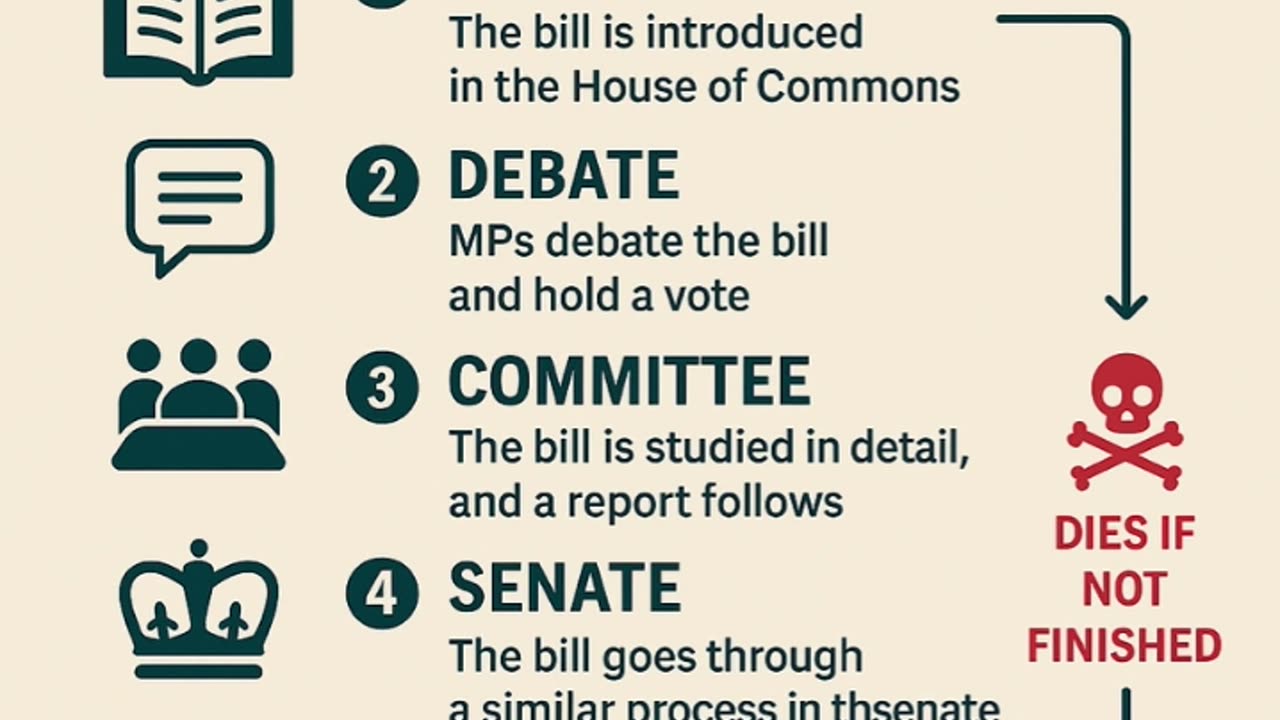Premium Only Content

💸 When a Bill Dies in Canada — and Why It’s a Huge Waste of Our Tax Dollars
💸 When a Bill Dies in Canada — and Why It’s a Huge Waste of Our Tax Dollars
Let’s break it down in plain English 👇
⸻
🏛️ What It Means When a Bill “Dies”
When Parliament is prorogued, dissolved for an election, or just doesn’t finish all its steps in time, every unfinished bill dies on the Order Paper.
That means:
• All the debates, committees, witnesses, research, translation, printing, and legal drafting — paid for by us — vanish.
• MPs can re-introduce the same bill later (often with a new number, like C-26 → C-8).
• The process starts from scratch, even if 95 % of it was already done.
👉 So yes — millions of dollars and months of work disappear.
⸻
⚖️ Why Bills Die
1️⃣ Parliament shuts down (prorogued or dissolved)
The government decides to “reset” Parliament. Every unfinished bill is wiped.
(Example: C-26 died when Parliament reset, so they brought it back as C-8.)
2️⃣ It didn’t have enough support
Opposition parties or senators blocked or delayed it.
3️⃣ It was too controversial
They let it quietly die before an election — then rebrand it later with a new number and softer language.
⸻
🧩 What “Re-Introducing” a Bill Really Means
They’re basically saying:
“Canadians didn’t want it the first time, but we’re trying again — with maybe a few tweaks.”
That’s why people call it “legislation by persistence.”
They wait until the public stops paying attention — then bring it back under a new name.
⸻
💰 Why It Wastes Taxpayer Money
Each version requires:
• Legal drafters & translators ( thousands of staff hours )
• Committee hearings (MPs, clerks, witnesses, security )
• Printing, publication, and web hosting
• House time that could’ve been spent on something else
💸 It’s basically recycling failed laws at our expense.
⸻
🚨 What “Everyone Didn’t Agree” Really Means
If a bill dies, it’s usually because:
• Opposition parties voted against it
• The Senate stalled it
• Or Canadians spoke out (loud backlash, petitions, pressure)
So when it returns under a new number, it’s a sign the government still wants the same powers Canadians already rejected.
Bill Life Cycle Chart:
1️⃣ First Reading → 2️⃣ Debate → 3️⃣ Committee → 4️⃣ Senate → 5️⃣ Royal Assent → ☠️ Dies if not finished → 🔁 Re-introduced later (new number, same idea)
https://open.substack.com/pub/demandcontrol/p/when-a-bill-dies-in-canada-and-why
-
 1:34
1:34
Canadian Citizens Journal
56 minutes agoArrested 68 year-old judge James Gosnell Junior, who is a South Carolina magistrate judge
-
 1:13:42
1:13:42
Sarah Westall
4 hours agoHow Bitcoin was Hijacked, Palantir is a Deep State Upgrade & more w/ Aaron Day
11.7K3 -
 15:59
15:59
ArynneWexler
6 hours agoAll The Reasons You're Right to Fear Zohran Mamdani | NN6
2.32K -
 LIVE
LIVE
Side Scrollers Podcast
10 hours ago🔴FIRST EVER RUMBLE SUB-A-THON🔴DAY 4🔴BLABS VS STREET FIGHTER!
930 watching -
 LIVE
LIVE
DLDAfterDark
2 hours agoGlock's Decision - How Could It Impact The Industry?
175 watching -
 25:57
25:57
The Kevin Trudeau Show Limitless
1 day agoThe Sound Of Control: This Is How They Program You
32.8K8 -
 8:29
8:29
Colion Noir
13 hours agoThree Masked Idiots Show Up at Her Door — Here’s What Happened Next
40.3K21 -
 15:38
15:38
Cash Jordan
7 hours agoPortland Zombies EMPTY 52 Stores… Mayor FREAKS as “Sanctuary” SELF DESTRUCTS
52.2K64 -
 1:23:21
1:23:21
Precision Rifle Network
1 day agoS5E4 Guns & Grub - Dustin Coleman of ColeTac
10.4K2 -
 1:09:25
1:09:25
Donald Trump Jr.
8 hours agoCorrupt UN Carbon Tax Exposed, Interview with John Konrad | TRIGGERED Ep.285
156K76